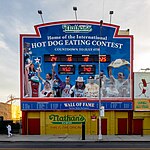B&B Carousell

The B&B Carousell is a historic carousel at Coney Island in Brooklyn, New York City. It was built by Coney Island-based manufacturer William F. Mangels c. 1906–1909, with wooden horses carved by Marcus Illions. The carousel has been relocated and refurbished several times over its history. The B&B Carousell has been located in Luna Park since 2013. The "Carousell" in the attraction's name is derived from the way Mangels's brochures spelled the word, while the "B&B" refers to two former owners. Charles Carmel crafted replacement horses for the B&B Carousell in 1927, and August Wolfinger painted murals on the carousel's rounding boards in the 1940s. It is the last operating carousel in Coney Island, and in 2016, it was listed on the National Register of Historic Places.
Excerpt from the Wikipedia article B&B Carousell (License: CC BY-SA 3.0, Authors, Images).B&B Carousell
Riegelmann Boardwalk, New York Brooklyn
Geographical coordinates (GPS) Address External links Nearby Places Show on map
Geographical coordinates (GPS)
| Latitude | Longitude |
|---|---|
| N 40.5731 ° | E -73.9832 ° |
Address
B&B Carousel
Riegelmann Boardwalk
11224 New York, Brooklyn
New York, United States
Open on Google Maps










